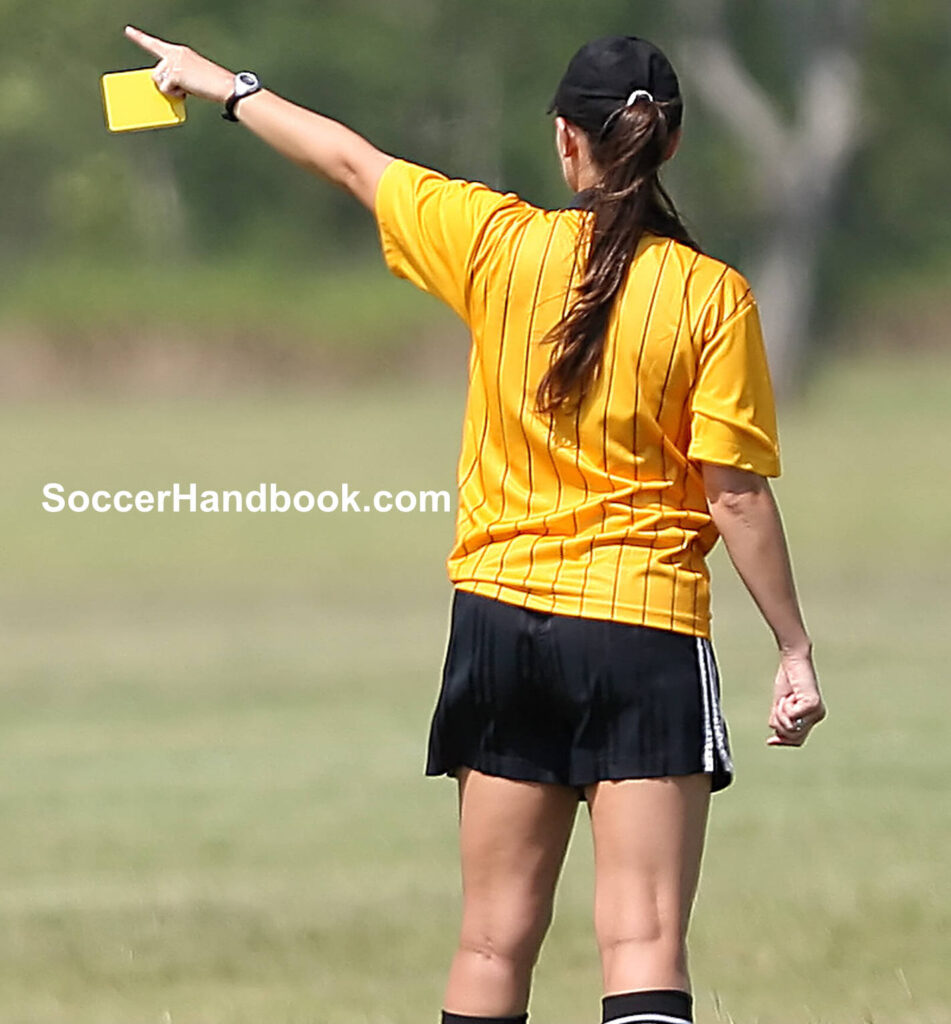Yellow cards are an essential part of soccer. They serve as an initial warning for players, cautioning them to avoid committing further fouls. This is also called a “booking” because the referee enters the player in their “referee book.”
If a player receives two yellow cards in one match, they are given a red card and have to leave the field, and may be suspended for upcoming games.
In the English Premier League and German Bundesliga, as well as other leagues, you can be suspended for several matches if given enough yellow cards throughout the season. Suspensions are given to ensure players try to keep the games cleaner.

History of the Yellow Card
The yellow card is a relatively recent development in soccer. Previously the referee could warn players and send them off. But it was entirely up to the referee since there was no system. However, in 1962, Chile and Italy faced off in one of the most violent games in World Cup history — it is now known as the Battle of Santiago.
The match’s referee, Ken Aston, struggled to control the players in a very chaotic game. He sent off two players, one of whom was dragged off the field after refusing to leave. This game inspired him to invent yellow and red cards eight years later, in 1970. Yellow cards warn players before they are removed from the game with a red card by the referee.
How do you get a Yellow Card in Soccer?
Fouls and yellow cards can be subjective. What is a yellow card for one referee may not be the same for a different referee. For example, people often accuse referees in Spain of giving out too many yellow cards. However, in general, there is a set of guidelines for fouls to dictate what should result in a yellow card.
Dissent:
This is when players intentionally ignore or disrespect the referee, whether verbally or otherwise. Insulting the referee, for example, counts as dissent. Although if the insult is abusive, a red card may be given. Another example of Dissent is walking away from the referee while he is trying to say something.
Persistent Infringement:
If a player consistently commits minor fouls, such as tripping a player or tugging an opponent’s jersey, they may be given a yellow card. The booking is to prevent players from taking advantage of non-cautionable fouls and to warn players not to commit too many fouls.
Delaying the Restart of Play:
This typically occurs toward the end of the game when the winning team may be trying to kill time. If players wait a long time before putting the ball back into play. Goalkeepers, in particular, often do this on goal kicks. They then receive a yellow card to encourage them to speed things up and not waste time.
Not Respecting the Required Distance:
This is related to delaying the restart of play. When a free kick occurs, the opponent’s wall must be at least ten yards away.
However, opponents will sometimes stand directly in front of the free kick taker to prevent a quick restart or waste time. Similarly, players stand directly in front of throw-ins. This is also a yellow card offense.
Entering and Re-entering the Field Without Permission:
If a player is injured, they may need to head to the sideline to be evaluated by the physios. The Player will be booked if they re-enter the field before the referee approves it. Someone who comes onto the field as a substitute must ask the referee for permission. If they come on without permission, they will get a yellow card.
Leaving the Field Without Permission:

Players don’t just need the referee’s permission to enter the field. They also need it to leave the field. If a player walks off the field without the referee’s knowledge or consent, the referee will book them. This is because the referee needs to be aware of everything happening in the game, especially the players on the field.
Unsporting Behavior:
This can be many things. Unsporting behavior is anything considered bad sportsmanship, ranging from excessive celebrations to attempting to deceive an official, like diving. Cristiano Ronaldo often takes off his shirt to celebrate scoring a goal, which fits into this category.
Referees can also give yellow cards for other reasons. Often, if a player attempts a poor tackle but not an overly dangerous challenge, the player may receive a yellow card.
Soccer Foul vs. Yellow Card
A foul is called when an illegal action from an opponent disrupts the game. The referee can give a yellow card for a foul, but a foul does not necessarily have to result in a card being issued. The referee often calls a foul and awards a free kick for something minor.
Fouls typically result in a free kick. However, players may not receive a yellow card for certain actions. These actions include pulling a shirt, tripping, pushing, or accidentally touching the ball with their hand.
However, this also depends on the scenario. Pulling on an opponent’s shirt while they are running downfield could result in a yellow card. The infraction could be a red card if the opponent has passed the last defender.
or even a red
How do Yellow Cards Work?
Usually, the referee is forgiving initially, as they don’t want to penalize a player too soon in the match. Players should be more careful after receiving a yellow card and play less aggressively to avoid getting another one.
Once a player receives a second yellow card, the referee shows them the red card, and they must leave the field. In most scenarios, the second yellow card is for a harsher foul than the first, but not always. It can also be an accumulation of multiple fouls after the first yellow.
Can Yellow Cards Be Overturned?
Often, referees review serious fouls to see if there was a red card offense in a play using VAR (Video Assistant Referee). If the referee initially gives a yellow card but then checks VAR and decides it should be a red card, he can change it to a red.
After reviewing the video on a penalty appeal, the referee can also decide to take away the yellow if he determines it was not a penalty or a yellow card offense. For example, the referee initially gave a yellow card for a handball in the penalty box. Then, after a review, determined it was not a handball. They then have to rescind the yellow card as well.
If the referee gives no card, he cannot check whether it should have been a yellow card. However, a card can be given later if VAR determines a foul was not called.
A yellow card can also be overturned if one of the referee’s assistants recommends that it should not be a yellow card. However, the referee is not required to accept this advice.
Final Thoughts
While they may seem irritating, yellow cards actually help both players and referees tremendously. With yellow cards, players know how close they are to being sent off, as a yellow is an initial warning. For referees, it allows them to control the game better and avoid violent matches.






